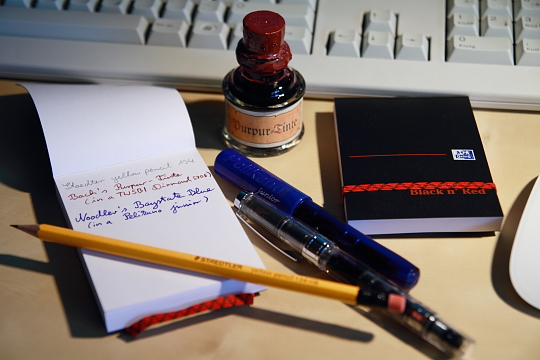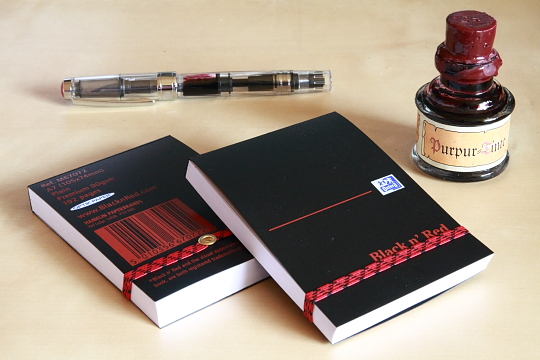Kronenheft

Back from Germany, I am going to try another four-in-one blog post. I did not take part in the Faber-Castell factory tour mentioned in one of the previous comments because of a bereavement – which resulted in a very different trip than planned. I hope to take part in one of their factory tours in December and hope to find the time to visit Staedtler’s shop in Nuremberg, too.
This is going to be a four-in-one blog post because I want to speed things up as there are so many things I want to write about but I do not write enough blog posts – so the queue gets longer and longer. The low number [1]i.e. one of comments on the previous four-in-one blog post about the Black n’ Red polynote does however make me think that writing about multiple items in one blog post does not give each individual item the attention it deserves, so I might switch back to one or two items per post…
…but today another (the last?) many-in-one blog post.
Kronenheft
The Kronenheft must be one of the most understated notepads available. I bought mine at Antiquariat Daniel Osthoff in August 2010. I mentioned this shop and some of the papers they sell in my blog post about the OHTO Super Clip. The Kronenheft notepad has been on the market for many years and is distributed by Carta Pura. It measures 15 cm x 10 cm and features a 290 g/m² Preßspanersatzkarton cover, an “imitation particle board” traditionally used, amongst other things, for book covers. It is a sturdy material made from wood pulp. The paper of this pad is 80 g/m² Salzer Werkdruck paper from Austrian paper manufacturer Salzer. Even though paper has been manufactured in Salzer’s town since 1469 and at the their mill, Obere Papiermühle, since 1579, the history of Salzer is slightly younger as the founder Kaspar Salzer did not have his own paper mill until 1798. Even though the 80 g/m² Salzer Werkdruck paper is not their best paper it is very good with a great feel and texture and a slightly creme-coloured tint.
Carta Pura, the distributor, sells this notepad in twelve different colours for € 7 each. You can also get a refill (40 sheets) for € 3. I paid less, but I am not sure how much exactly. FontShop used to sell them for a good price, but when I check recently I could not find it in their online shop any more.

Morning Glory
This is the second appearance of a Morning Glory pencil at Bleistift. The first appearance was last month, when I wrote about RAD AND HUNGRY’s STMT X Korea kit. This time I used a much older Morning Glory pencil that my wife bought about ten years ago, the morning glory No. 33322-45229 HB. You would think that such a long product number can definitely point to one specific type of pencil, but there are actually different versions of the morning glory No. 33322-45229 HB pencil, with different colours printed on the pencil, but with the same product number.
The pencil itself writes very well. It could be a bit smoother, but it is by no means a scratchy pencil.
Pelikan M100
Since today is Star Wars day (May the Fourth be with you) I have to include the Pelikan M100, too. I cannot look at this pen without thinking of Stormtroopers and am convinced that if Stormtroopers had fountain pens this Pelikan M100 would be standard issue! It is a great fountain pen and all of its parts are either white or black, even the nib is black. The piston mechanism does not feel as smooth as it does with a Pelikan M200 or a Souverän, but when this fountain pen was released in 1987 it was not an expensive pen so it is no surprise that the piston mechanism is not on the same level. The nib however is excellent for a steel nib and is quite flexible, too.

Noodler’s X-Feather ink
The ink used in the M100 is Noodler’s X-Feather ink, a black ink that is bulletproof, i.e. resistant to bleach, chemicals, light, etc. I have used this ink for years and am very happy with it. There is only one disadvantage I noticed. If you use it in a wet writer and use paper that does not absorb ink easily (e.g. post cards) it can happen that a layer on top of the ink does not ‘dry’ completely. In this case it can smudge or smear, even days after the text has been written. Under normal circumstances this is however not really a problem.
Conclusion
The Kronenheft is just great, but with its price tag I am not sure I will use it often. It copes well with ink (no bleeding though) and pencil and has a nice colour and texture.
You can find another photo of the Kronenheft in my previous blog post Wooden Letter Rack with Draw.
You can find English blog posts about Carta Pura at bloesem travel and at snowflakes & blackvampires.
Noodler’s X-Feather ink has also been used in my previous blog post Carrefour Bloc-notes.
I’d like to thank Ms Schwamborn from Carta Pura for additional information about the Kronenheft.
In case you wonder where my Cherry G80-3000LSC went: the photos show my wife’s desk, which is very similar – except the keyboard.
References
| ↑1 | i.e. one |
|---|











